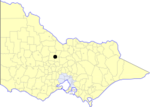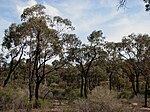Bendigo Base Hospital
1853 establishments in AustraliaAustralian hospital stubsBendigoBuildings and structures in BendigoHospitals established in 1853 ... and 2 more
Hospitals in Victoria (state)Victoria (state) building and structure stubs

Bendigo Base Hospital is the major hospital of Bendigo, Victoria, Australia. It is operated by Bendigo Health Care Group (commonly known as Bendigo Health). The hospital is the largest regional hospital in Victoria and one of the largest public hospitals in Australia with a total of 734 beds. As of 2019, the hospital employs around 4,000 staff and provides a wide range of services to a catchment area covering one-fourth of the size of Victoria state.
Excerpt from the Wikipedia article Bendigo Base Hospital (License: CC BY-SA 3.0, Authors, Images).Bendigo Base Hospital
Davidson Street, Bendigo North Bendigo (North Bendigo)
Geographical coordinates (GPS) Address Nearby Places Show on map
Geographical coordinates (GPS)
| Latitude | Longitude |
|---|---|
| N -36.7327 ° | E 144.2683 ° |
Address
Davidson Street
3550 Bendigo, North Bendigo (North Bendigo)
Victoria, Australia
Open on Google Maps







